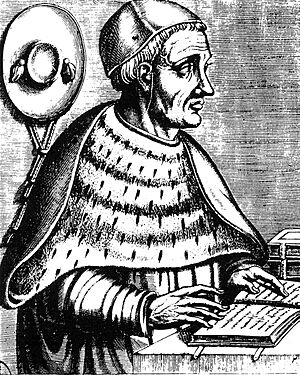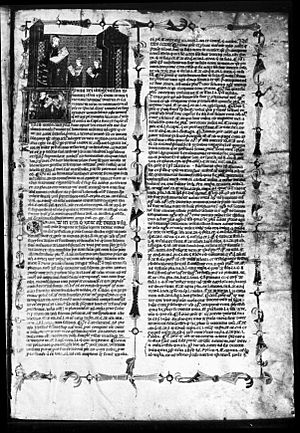Pierre d'Ailly facts for kids
Pierre d'Ailly (born in 1351, died in 1420) was a smart French thinker. He was a theologian, which means he studied religion. He was also an astrologer, someone who studied how stars and planets might affect events. Later, he became a cardinal in the Roman Catholic Church. He played a big role in trying to fix a major problem in the church called the Great Schism.
Contents
Learning and Teaching Career
Pierre d'Ailly was born in Compiègne, France. His family was well-off. He went to study in Paris at the Collège de Navarre. He earned his first degree in 1367 and a master's degree a year later. He became very active in university life by 1372.
He taught the Bible in 1375. He also taught about the Sentences by Peter Lombard, which was a very important religious book. In 1381, he earned his doctorate in theology. He even became the head of the university, called the rector, in 1384. Two of his famous students were Jean Gerson and Nicholas of Clémanges.
The Great Schism and University Efforts
A big problem started in the church in 1378. It was called the Great Schism. This meant there were two popes at the same time, one in Rome and one in Avignon, France. Pierre d'Ailly wanted to end this division.
In 1381, the University of Paris decided that a general council (a big meeting of church leaders) was the best way to fix the problem. Pierre d'Ailly supported this idea. He even spoke to the king's council about it. However, the government was not happy, so the university had to stop this plan for a while. Pierre d'Ailly then went to Noyon.
He later returned to the university. He helped remove John Blanchard as the university's chancellor. Pierre d'Ailly also went on missions to the Avignon pope, Antipope Clement VII. He defended the university's beliefs, like the Immaculate Conception. He also asked the pope to make Pierre de Luxembourg a saint. His success in these missions helped him become the king's almoner (who gives money to the poor) and confessor (who hears confessions). He also became the chancellor of Notre Dame de Paris.
Pierre d'Ailly served as chancellor of the University from 1389 to 1395. His student, Gerson, took over after him. Both of them worked to end the Great Schism. They believed a church council could solve the problem.
When Antipope Benedict XIII became pope in Avignon in 1394, Pierre d'Ailly was sent to congratulate him. He spoke very politely to the new pope. However, the University of Paris was tired of the schism. They wanted both popes to resign. Pierre d'Ailly had supported this idea before. But after visiting Benedict XIII, his strong feelings about it seemed to cool down.
His actions made some people at the university suspicious. Especially when he became the bishop of Le Puy in 1395. He held many church positions, which made some wonder if he was just looking out for himself. Because of these doubts, he was sometimes kept out of university meetings about the church's unity.
Church Leadership Roles
Pierre d'Ailly's career in the church continued to grow. After being bishop of Le Puy, he became bishop of Noyon. Then, in 1397, he became the Bishop of Cambrai. This position also made him a prince of the Holy Roman Empire.
To take his new role in Cambrai, he faced many challenges. He had to deal with the anger of Philip the Bold, a powerful duke. He also faced resistance from local church leaders and citizens. Even some lords attacked him. But his supporter, the Duke of Orleans, helped him get the position.
From this point on, Pierre d'Ailly spent most of his time trying to end the Great Schism. At first, he was slow to support the idea that a council should solve the problem. But by 1409, he was actively taking part in church councils.
Efforts to End the Schism
France tried to force Benedict XIII to give up his power. They threatened to stop following him. Pierre d'Ailly, who had been loyal to the pope, joined the kingdom in this action. But in 1403, he advised and celebrated when France decided to follow Benedict XIII again. He was sent by King Charles VI to Benedict. He used this chance to congratulate the pope and give him advice.
In 1406, at a church council in Paris, Pierre d'Ailly worked hard to prevent France from withdrawing its support from Benedict XIII again. He even defended Benedict XIII on the king's orders. This made the university party, who wanted the pope to resign, angry with him.
The next year, he and his student Gerson were part of a group sent to both popes. While in Italy, he tried to convince the Roman pope to move closer to his rival. The hope was that both popes would then resign. But his efforts failed. He returned to Cambrai in 1408. He was still loyal to Benedict at this time. The king's government was angry that he didn't want to support their declaration of neutrality. They even ordered his arrest, but it was not carried out.
Church Councils and New Popes
Finally, the cardinals from both sides called for the Council of Pisa in 1409. Pierre d'Ailly then stopped supporting Benedict XIII. He believed that a council was the only way to save the church. He argued that in a schism, anyone faithful could call a council. This council would have the right to judge and even remove the rival popes.
Pierre d'Ailly took part in the Council of Pisa. The council declared that both the Roman pope Gregory XII and Benedict XIII were removed. Then, they elected Alexander V as the new pope in June 1409. This pope only reigned for ten months. His successor, John XXIII, made Pierre d'Ailly a cardinal in 1411. John XXIII also gave him control of other bishoprics, like Limoges and Orange. He also made Pierre d'Ailly his special representative in Germany in 1413.
Despite these favors, Pierre d'Ailly became one of John XXIII's biggest opponents at the Council of Constance (1414–1418). He was a leading theologian at this council, along with Gerson. He strongly believed that the church needed unity and reform. He helped push the idea that since the schism continued after the Council of Pisa, they needed to work for a true union. This meant not worrying about the rights of John XXIII, Gregory XII, or Benedict XIII.
Pierre d'Ailly played a very important role in the first few months of the council. He refused to defend John XXIII. Instead, he gave statements against him during John XXIII's trial. These statements were sometimes very damaging.
At Constance, he also focused on other important matters. These included condemning the ideas of John Wycliffe and the trial of Jan Hus. He also argued that the English should not have their own separate group in the council. He wanted to reduce their power. This made the English very angry, but it showed his role as a defender of the King of France.
When it was time to choose a new, single pope for the Christian world, Pierre d'Ailly defended the cardinals' right to be part of the election. He helped create a system that combined the council's wishes with the cardinals' rights. This led to the election of Pope Martin V in 1417. With this, Pierre d'Ailly's main task was finally done.
Later Life
After the Council of Constance, Pierre d'Ailly went back to Paris. However, there was fighting in France. When one group took control of Paris in 1419, he fled south. He retired to Avignon. His former student, Gerson, also settled nearby. Pierre d'Ailly, known as the Cardinal of Cambrai, passed away in Avignon in 1420.
Important Writings
Pierre d'Ailly wrote many books and papers. He wrote about the Great Schism, church reform, and astrology. His ideas about the power of the college of cardinals and the idea that a general council could not be wrong were very important.
One of his most famous works is Imago Mundi (1410). This book was about cosmography, which is the study of the universe and Earth. This book actually influenced Christopher Columbus! Columbus used d'Ailly's ideas to estimate the size of the world for his voyages.
Pierre d'Ailly was also interested in science and astrology, like how to fix the calendar. In his writings on astrology, he tried to balance God's all-knowing power with human free will. His writings about the Schism also connected the church crisis to ideas about the end of the world. He even used astrology to try and figure out if the church's division was a sign of the Antichrist coming. His works were printed and read widely even before the 1500s.
Legacy
The crater Aliacensis on the Moon is named after him.
Works and translations
- Quaestiones super libros Sententiarum (1376–1377)
- Petrus de Alliaco Questiones super primum, tertium et quartum librum Sententiarum. I: Principia et questio circa Prologum (2013)
- Ymago Mundi de Pierre d'Ailly (1930)
- De concordia astronomice veritatis et narrationis historice (1414)
- Tractatus de concordantia theologie et astronomie (1414)
- Destructiones modorum significandi (1994)
- Tractatus de anima (1987)
- Tractatus super De consolatione philosophiae (1988)
- Conceptus et insolubilia (circa 1495)
- Concepts and Insolubles: An Annotated Translation (1980)
- Destructions modorum significandi. Conceptus et insolubilia (circa 1490–1495)
- Tractatus exponibilium (1494)
Images for kids
See also
 In Spanish: Pierre d'Ailly para niños
In Spanish: Pierre d'Ailly para niños




